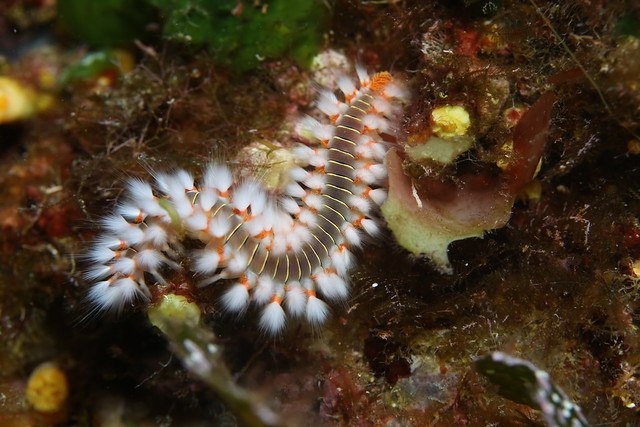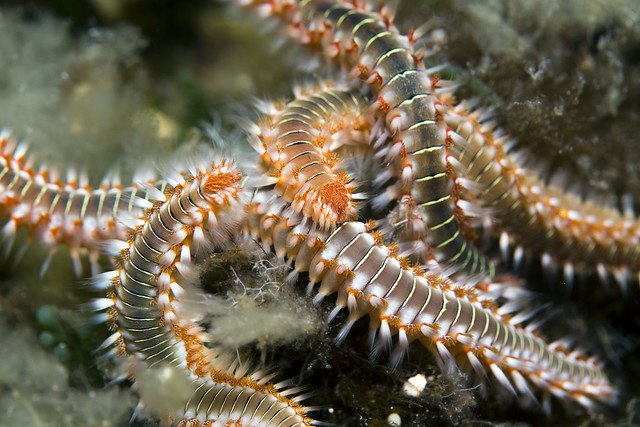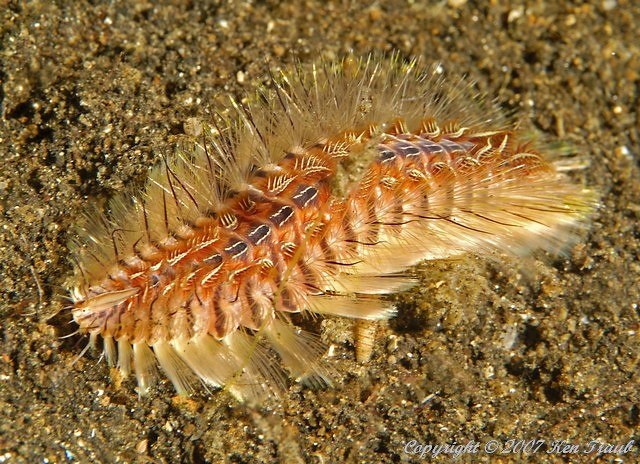Have you noticed the appearance of worms in your saltwater tank? You may have an infestation of bristle worms – a fairly common occurrence in saltwater aquariums.
Exactly what are bristle worms? Are they harmful to your aquarium life? And if they are, then how do you safely get rid of them?

If you’re trying to figure out how to catch bristle worms and get rid of them, we have all the information you need.
Contents
What Are Bristle Worms?
A bristle worm is a saltwater worm with a soft, segmented body. This body has numerous, small, hair-like bristles along the sides.
Each segment of the body also has a pair of parapodia, a kind of appendage that the worm uses to move around. Most bristle worms also have a head with sensory palps as well as eyes and antennae.
Bristle worms belong to the scientific class polychaeta. There are over ten thousand species in this class! The word “polychaeta” means “many hairs,” and refers to the many bristles that can be seen along the worm’s body.
Because there are literally thousands of species of bristle worms to be found on Earth, there is quite a lot of diversity to be found in this group.
These species include:
- Bloodworms
- Common clamworms.
- Freckled paddle worms.
- Red-lined worms.
- Common bamboo worms.
- Trumpet worms.
Some species can grow up to 24 inches in length, though most bristle worms you find in your saltwater aquarium will stay around one to six inches long.
Bristle worms are also closely related to earthworms and leeches.
Where Do You Find Bristle Worms?
Polychaetes have been found all over the world, and in every kind of marine habitat, from coral reefs, to hydrothermal vents, to the open ocean.
Remember, since there are over ten thousand species of bristle worm, they have a lot of differences between them!
Some have parapodia, which allow them to swim through the sea, while others have limbs, which are useful for walking across the ocean floor or burrowing deep in the mud.

One species of bristle worm, known as the Pompeii worm, can survive at temperatures well over one hundred degrees Fahrenheit! That’s a pretty intense water temperature.
In an aquarium setting, bristle worms prefer to live inside the live rock or the substrate lining the bottom of your tank, such as sand or gravel.
Where Do Bristle Worms Come From?
Often a bristle worm will find its way into a saltwater aquarium by riding in on a piece of live rock. It is therefore important to inspect all pieces of rock that you introduce to your aquarium for bristle worms.
You can do this by laying out the rock on a piece of newspaper, or on a linen or plastic sheet. You will be able to see the worms crawling around or sticking out of the pieces of rock. Then you can take a pair of tweezers and carefully pull the worm out of the rock.
Some types of bristle worms may enter your tank by hitching a ride on another saltwater invertebrate. Around four hundred species of bristle worms live in host animals, sometimes harming the host as a parasite, while other times taking on a more benign presence by practicing commensalism.
Though there are many of these kinds of bristle worms, they are less likely to be found in an aquarium tank, and less likely to be a detriment to the life of your aquarium fish than other kinds of bristle worms.
Naturally, once there is a bristle worm in your tank, you are likely to end up with more of them. Bristle worms have a wide range of reproductive processes.
Most of these worms reproduce sexually, releasing sperm and eggs into the water for fertilization. Other species of bristle worms reproduce asexually, through a budding process. Some types of bristle worms raise their young, while others are alone from birth.
Overall, bristle worms are more likely to breed when there is more food available to them. Bristle worms can eat most of the food your regular aquarium fish do. Therefore, if you overfeed your aquarium, you are more likely to discover that bristle worms are breeding in there!
How to Spot Bristle Worms
It can be easy to miss a bristle worm, and they can live in your tank for a while without you noticing their presence. Because they are nocturnal animals, the worms will generally only come out of their shelter in the sand or the rocks of the tank when it is dark outside.

If you suspect that your tank has bristle worms in it, turn out the lights in the room and the aquarium, and wait nearby with a flashlight.
You will want to use a red light instead of a white one to avoid scaring off the worm. Red light is more difficult for nocturnal animals such as bristle worms to perceive.
Either get a flashlight with a red light setting, or cover the bulb end of the flashlight with red vellum paper or acetate to get the same effect.
After you turn out the lights, the worm will soon come out from behind a rock or beneath the sand. You may also need to agitate the sand with a small net to startle the worm out of its hiding place.
What’s the Problem with Bristle Worms?
Not all bristle worms are harmful to your aquarium life. Some of them work as the housekeepers of an aquarium’s ecosystem, snacking on algae, feces, and other detritus, ultimately keeping your tank clean.
The issue is that some species of bristle worms can be voracious eaters, and aggressive predators. These worms are not very picky about what they have to eat, preying on both mobile and stationary marine life.
While their most common prey are invertebrates, such as mollusks and crustaceans, or other stationary organic matter such as plankton, algae, or coral, bristle worms may also eat small fish – the kinds you may have in your home aquarium!
The kind of bristle worm that you really need to focus on keeping away from your aquarium fish is the “fireworm” family. These worms have bristles with toxic tips, which inflict an incredibly painful sting.
They also have particularly strong jaws, making them a fearsome predator to aquarium fish, and can rapidly reproduce, which can make getting rid of them an even more urgent matter. One or two bristle worms are much easier to handle than a large family!
Now it’s time for you to learn how to get rid of bristle worms.
How to Remove Bristle Worms
It can be difficult to kill a bristle worm. When handled, many bristle worms will easily break apart into their segmented pieces.
This does not kill them; rather, the worms are able to regenerate the limbs that were lost or damaged in the process.
The important thing is to be patient and thorough while getting rid of bristle worms, whether you use a bristle worm trap or another method.
This video goes into more details about bristle worms.
Tweezers and Nets
It is possible to remove bristle worms by hand when you see them, using a pair of tweezers or a net. However, through this method it is easy to accidentally miss a worm or to break them apart without actually catching them.
If you do decide to catch the worms by hand, always remember to wear a pair of gloves while dealing with bristle worms. You don’t want to come into contact with the stinging toxic bristles of a fireworm!
Natural Predators
Another option is to add a natural predator of bristle worms to your aquarium tank.
These animals will take care of the bristle worms for you, and might just be a welcome addition to your little community of saltwater fish!
Marine animals which eat bristle worms include:
- Dottybacks.
- Bird wrasses.
- Maori wrasses.
- Sunset wrasses.
- Coral banded shrimp.
- Arrow crabs.
If you decide to introduce a predator to your tank, be sure to do your research first about what else this animal eats. You definitely don’t want to accidentally introduce a crab that will eat the fish you want to keep to your tank!

This method is usually seen as a last resort by aquarium hobbyists. The most popular way to get rid of bristle worms is to set a bristle worm trap in your aquarium tank.
Types of Bristle Worm Traps
There are many different types of bristle worm traps. Some of them you can buy already made in a pet store, while others you can make at home.
Here are some examples, so you can select one that best fits your needs.
Small Opening Traps: These traps are usually made from plastic or acrylic materials. The trap has a small opening, which the bristle worm can crawl into but not get back out of.
Just place some worm food inside and wait for the creatures to trap themselves! You can usually find these traps in your local pet store.
Large Door Traps: This kind of trap is similar to the small opening trap. The difference is that it has a large sliding door, which will slam shut as soon as something enters the trap, keeping the bristle worm secure until you can get rid of it!
Just be sure that your aquarium critters don’t get curious and investigate. You can often find these traps in your local pet store as well or from online retailers.
Homemade Trap: If the traps you can buy in a pet store or online are not working for you, you may want to try to make your own bristle worm trap at home.
- Take an opaque plastic container with a lid, such as a food storage container, and make an X-shaped cut in the lid of the container. Try to make sure that the X is just a bit smaller than the thickness of the bristle worm you noticed in your aquarium tank. A cut that is too wide will allow the worm to escape, while a cut that is too thin will prevent the worm from entering the trap in the first place.
- After cutting the X, use your finger or a tool to push the four triangular pieces of plastic made loose by the X inwards, leaving them at about a forty-five-degree angle. These inward-pointing triangles will allow the bristle worm to enter the trap easily. However, if the worm tries to get back out of the trap again, the plastic triangles will bend back into place, preventing the worm from escaping!
- After preparing the opening of the trap, place some bait inside. If, after a few days, you have not caught a bristle worm, you may need to adjust the size of the X-shaped cut.
Trapping Worms
Whatever kind of trap you decide to use, place one or more of these traps in the aquarium and leave some bait in it.
Make sure that you put the traps near the hiding places that you noticed while searching for the worms, such as by the rocks or the sandy parts of your aquarium.
Bait
Bait for bristle worms can include:
- Cooked shrimp meat.
- Raw scallop meat.
- Fish roe.
- Mussel meat.
- Raw clam meat.
- Pieces of edible fish.
Frozen fish do not attract bristle worms as much as fresh, raw, or cooked food does. Also, small pieces of food will attract the bristle worms more than large pieces will because they are small animals.
How Long to Wait
Leave the trap there overnight for at least one or two nights, and then check the traps for bristle worms.
Again, remember to wear gloves to avoid getting stung! If you have not caught any worms after 48 hours, replace the food inside with fresh bait to avoid it decaying in your aquarium water.
This video shows an example of a bristle worm trap.
Conclusion
Catching bristle worms requires a lot of patience and tenacity. If you don’t succeed right away, adjust your trap and do not give up! You can protect your aquarium life from invading worms.
Now that you know what bristle worms are and how to get rid of them, you are prepared to keep your aquarium fish healthy and safe!
How do you deal with bristle worms in saltwater tanks?

